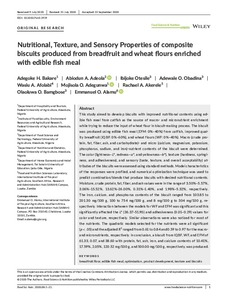| dc.contributor.author | Bakare, A.H. |
| dc.contributor.author | Adeola, A.A. |
| dc.contributor.author | Otesile, I. |
| dc.contributor.author | Obadina, A.O. |
| dc.contributor.author | Afolabi, W.A. |
| dc.contributor.author | Adegunwa, M.O. |
| dc.contributor.author | Akerele, R.A. |
| dc.contributor.author | Bamgbose, O.O. |
| dc.contributor.author | Alamu, E.O. |
| dc.date.accessioned | 2020-11-18T12:36:24Z |
| dc.date.available | 2020-11-18T12:36:24Z |
| dc.date.issued | 2020 |
| dc.identifier.citation | Bakare, A.H., Adeola, A.A., Otesile, I., Obadina, A.O., Afolabi, W.A., Adegunwa, M.O., ... & Alamu, E.O. (2020). Nutritional, Texture, and Sensory Properties of composite biscuits produced from breadfruit and wheat flours enriched with edible fish meal. Food Science & Nutrition, 1-21. |
| dc.identifier.issn | 2048-7177 |
| dc.identifier.uri | https://hdl.handle.net/20.500.12478/6996 |
| dc.description.abstract | This study aimed to develop biscuits with improved nutritional contents using edible fish meal from catfish as the source of macro‐ and micronutrient enrichment while trying to reduce the input of wheat flour in biscuit‐making process. The biscuit was produced using edible fish meal (EFM: 0%–40%) from catfish, improved quality breadfruit (IQBF: 0%–60%), and wheat flours (WF: 0%–40%). Macro (crude protein, fat, fiber, ash, and carbohydrate)‐ and micro (calcium, magnesium, potassium, phosphorus, sodium, and iron)‐nutrient contents of the biscuit were determined. The color (lightness—L*, redness—a*, and yellowness—b*), texture (hardness, springiness, and adhesiveness), and sensory (taste, texture, and overall acceptability) attributes of the biscuits were assessed using standard methods. Model characteristics of the responses were profiled, and numerical optimization technique was used to predict combination/blends that produce biscuits with desired nutritional contents. Moisture, crude protein, fat, fiber, and ash values were in the range of 3.50%–5.57%, 3.06%–15.52%, 13.62%–26.00%, 0.31%–1.40%, and 1.98%–5.32%, respectively. The iron, calcium, and phosphorus contents of the biscuit ranged from 103.85 to 201.30 mg/100 g, 100 to 754 mg/100 g, and 8 mg/100 g to 304 mg/100 g, respectively. Interaction between the models for WF and EFM was significant and this significantly affected the L* (36.37–51.90) and adhesiveness (0.01–0.29) values for color and texture, respectively. Similar observations were also noticed for most of the nutrients. The quadratic models selected for the nutrients were all significant (p < .05) and the adjusted R2 ranged from 0.61 to 0.84 and 0.59 to 0.97 for the macro‐ and micronutrients, respectively. In conclusion, a biscuit from IQBF, WF, and EFM of 61.33, 0.07, and 38.60 with protein, fat, ash, iron, and calcium contents of 10.41%, 17.59%, 2.05%, 120.52 mg/100 g, and 500.00 mg/100 g, respectively, was produced. |
| dc.description.sponsorship | Federal University of Agriculture, Abeokuta |
| dc.format.extent | 1-21 |
| dc.language.iso | en |
| dc.subject | Fish Meal |
| dc.subject | Optimization |
| dc.subject | Production |
| dc.subject | Development |
| dc.subject | Texture |
| dc.subject | Biscuits |
| dc.subject | Sensory Properties |
| dc.title | Nutritional, texture, and sensory properties of composite biscuits produced from breadfruit and wheat flours enriched with edible fish meal |
| dc.type | Journal Article |
| cg.contributor.crp | Agriculture for Nutrition and Health |
| cg.contributor.affiliation | Federal University of Agriculture, Abeokuta |
| cg.contributor.affiliation | Tai Solarin University of Education |
| cg.contributor.affiliation | International Institute of Tropical Agriculture |
| cg.coverage.region | Africa |
| cg.coverage.region | West Africa |
| cg.coverage.country | Nigeria |
| cg.coverage.hub | Southern Africa Hub |
| cg.researchtheme | Social Science and Agribusiness |
| cg.identifier.bibtexciteid | BAKARE:2020 |
| cg.isijournal | ISI Journal |
| cg.authorship.types | CGIAR and developing country institute |
| cg.iitasubject | Agribusiness |
| cg.iitasubject | Food Science |
| cg.iitasubject | Nutrition |
| cg.iitasubject | Socioeconomy |
| cg.iitasubject | Value Chains |
| cg.journal | Food Science & Nutrition |
| cg.notes | Open Access Article; Published online: 30 Sept 2020 |
| cg.accessibilitystatus | Open Access |
| cg.reviewstatus | Peer Review |
| cg.usagerightslicense | Creative Commons Attribution 4.0 (CC BY 0.0) |
| cg.targetaudience | Scientists |
| cg.identifier.doi | https://dx.doi.org/10.1002/fsn3.1919 |
| cg.iitaauthor.identifier | Alamu Emmanuel Oladeji: 0000-0001-6263-1359 |
| cg.futureupdate.required | No |

